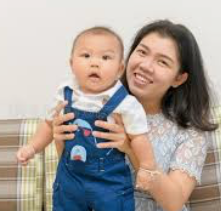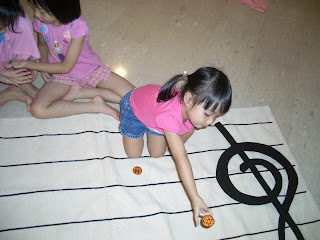montessori and suzuki piano classes . . .
premium, first-class, results guaranteed

Two and a half year old boy enjoying his work with the Golden beads. He is lining up several Tens with a Hundred. Through hands-on concrete objects, he learns the Decimal System of units, tens, hundreds. The next step for him would be to learn through hands-on experience the value of a thousand and a million.
square roots . . . age is no barrier
A delightful achievement

Having just read a book of funny rhymes, Amy, our brilliant four (4) year old young lady decides to move to the Small Moveable Alphabets to spells them out. Here's "tree", "see", "fee" and "drag", "grab", "crab". She quickly highlights this to everyone in class as she beams with delight at her achievement.
learning through discovery

Babies naturally enjoy rhymes, rhythm and songs. Here's a curious 9-month old exploring the piano. She realises that different keys have different pitches. Stringing them together, she discovers her own unique tune . . .
Kids at play
mother and child time
Natural desire of children
casa dei bambini
“Any child who is self-sufficient, who can tie his shoes, dress or undress himself, reflects in his joy and sense of achievement the image of human dignity, which is derived from a sense of independence.”
Maria Montessori concluded that the child needed meaningful work by which she could construct her personality. Thus, practical life and the Montessori method itself were born. So what exactly is the Montessori method? It would be nearly impossible to sum up the Montessori method in a few short paragraphs. However, the following terms will help provide a general idea of method as well as the philosophy behind it.
The method is child-centered. The teacher, called a director/directress in the Montessori setting, is there to guide the children in their work. The children are offered complete freedom within limits. The rules, as well as the physical layout of the classroom, are consistent and predictable, but the child is free to choose her work, workspace, and her work companions. This allows the child to feel secure, while developing a child’s independence and sense of self. The child may not initially be able to make choices for herself, but, as the child’s confidence grows, the directress can offer more freedom and allow the child to flourish with progressively less intervention. It is not the teacher’s role to do things for the children, nor is it her role to demand that the children do it themselves. Instead, it is her job to guide the child in her journey toward independence by offering assistance only when it is needed.
‘These words reveal the child's inner needs: "Help me to do it alone."’
The method is holistic. Our program certainly has a strong academic component, but this is by no means the core of the program. Our curriculum includes art, practical life, geography and culture, music, language, math, and, as the children get older, science and history as well. In the Montessori environment, the child’s mind and body are allowed to work together. The use of the body becomes more detailed and intricate as the child matures, and it is in this way that intelligence develops. Academic success is a natural outcome of the early practical life and sensorial experiences, which help the child develop logic, orderliness, concentration, brain organization, independence, self-discipline, and memory.
“Children show a great attachment to the abstract subjects when they arrive at them through manual activity. They proceed to fields of knowledge hitherto held inaccessible to them, as grammar and mathematics.”
Concentration is nurtured and protected in the classroom. We do this in several ways. First of all, we create a sparse, orderly environment that doesn’t overwhelm the child. Secondly, we allow the child to choose work that is interesting and meaningful to her. This increases the chances of a child entering a deep state of concentration. Finally, we protect the child from interruption. When a child is allowed to follow something through from beginning to end, not only are her independence and concentration nourished, but the child comes to see herself and her work as important.
“The first essential for the child's development is concentration. The child who concentrates is immensely happy.”
When the Montessori method is faithfully adhered to, we can often expect to see the child flourish in numerous ways. The child becomes a confident, independent, capable person of her time and place. She develops a capacity for concentration, a tendency to act in a responsible and self-disciplined manner, and an ability to find joy in work.
phonics
learning through discovery
Montessori vs Conventional Education
Montessori Education
Emphasis on cognitive structures and social development
Child is an active participant in learning.
Environment and method encourage internal self-discipline
Mixed age grouping
Multi-sensory materials for physical exploration
Child chooses own work based on abilities, high-ability children work at faster pace.
Conventional Education:
Emphasis on rote knowledge and social development
Child is passive participant in learning.
Teacher acts as primary enforcer of external discipline.
Same age grouping
Curriculum structured with little regard for child's natural interest
Curriculum pace is usually set by the group norm or teacher, every child works at the same pace regardless of their cognitive ability.
Mother and child
Nurturing the Love of Learning
Parents who learn songs to sing to their babies long before they are born find that these songs are very soothing to the infant after birth.
Just as with Montessori, the purpose of the Suzuki method is to create a loving relationship between child and adult, to give the child the joy of accomplishment and developed talents, and, by meeting the needs of children, to help create a more peaceful society. The best way to help children is to work with parents even before birth. Today Suzuki parent education classes, given to help parents prepare for their infants, are similar in many ways to Montessori parent education classes.
It is possible that the fetus absorbs the particular characteristic rhythms of the motherís language. In a sense the fetus is already at work, learning language! It is thus important to sing to the child even during pregnancy. The brain's growth during fetal life is astonishing, with 20,000 cells being added every minute. Dreaming begins at the end of the seventh month of pregnancy. —Silvana Montanaro, M.D., AMI Montessori teacher trainer















